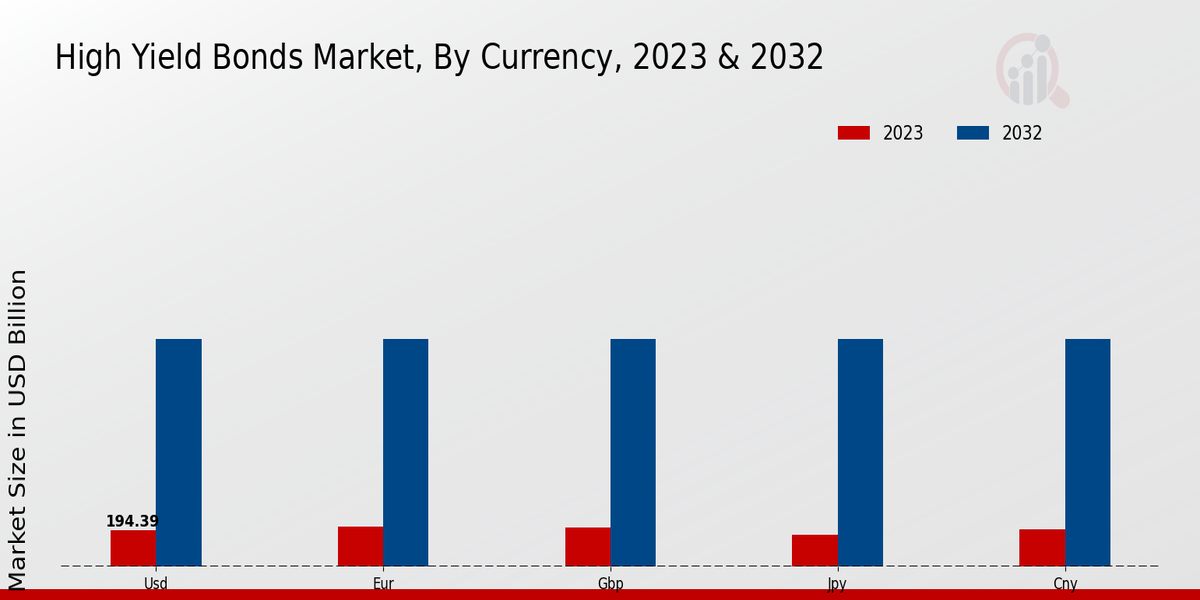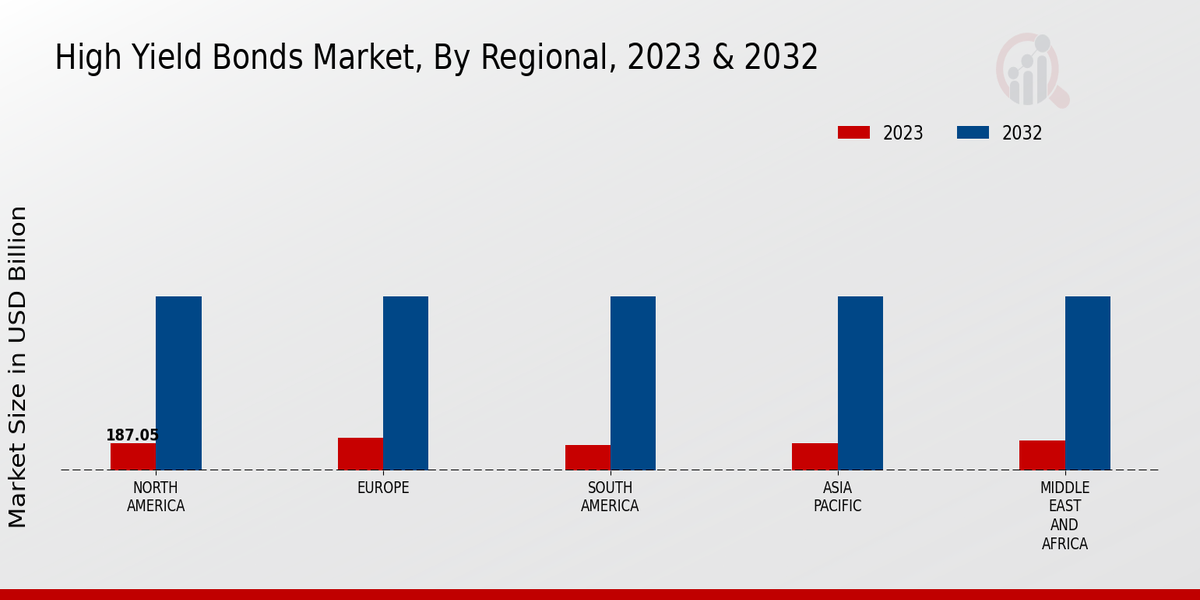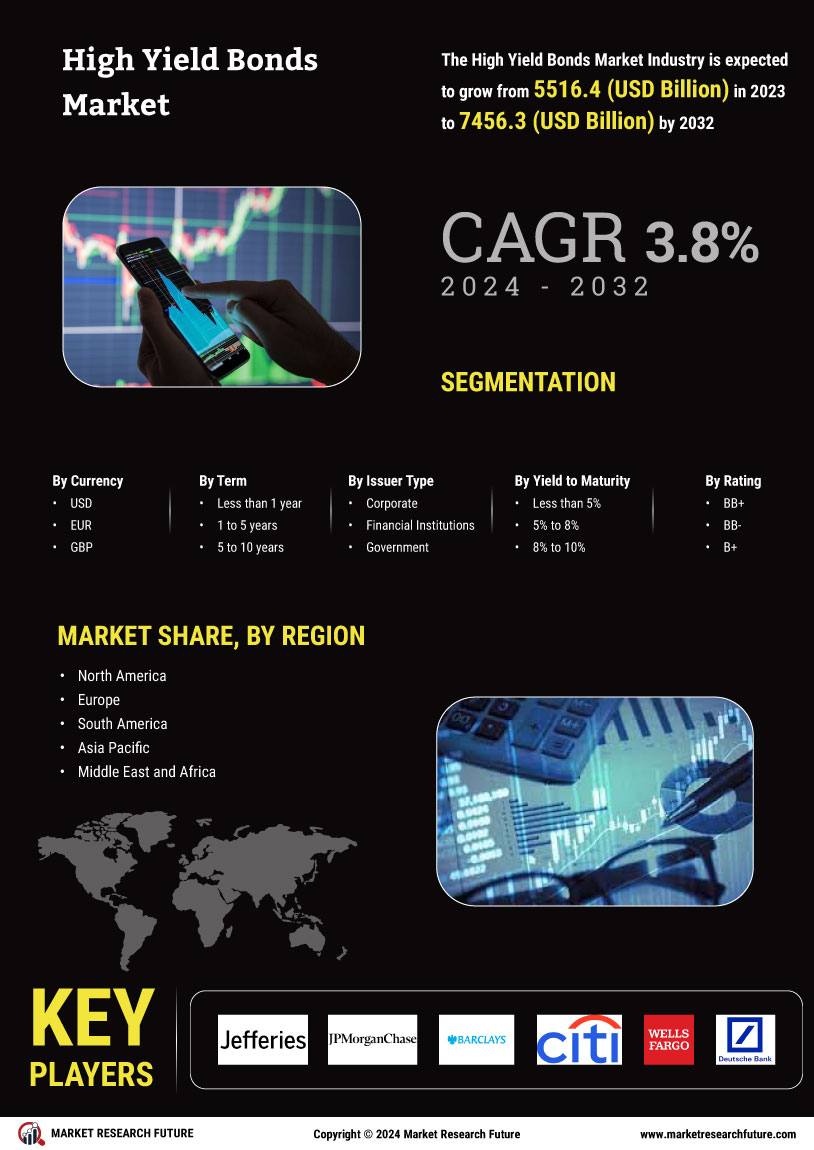Global High Yield Bonds Market Overview:
High Yield Bonds Market Size was estimated at 5981.72 (USD Billion) in 2024. The High Yield Bonds Market Industry is expected to grow from 6210.24 (USD Billion) in 2025 to 8702.55 (USD Billion) till 2034, exhibiting a compound annual growth rate (CAGR) of 3.8% during the forecast period (2025 - 2034)
Key High Yield Bonds Market Trends Highlighted
The global high yield bond market exhibits significant growth potential, driven by several key market drivers. One major factor influencing the market is the increasing demand for higher yields by investors seeking to enhance returns in a low-interest rate environment. Moreover, the shift towards alternative investment strategies has led to increased allocation to high yield bonds that provide diversification benefits and potential for alpha generation.
Opportunities within the market lie in the expansion of emerging market high yield bonds, which offer diversification benefits and attractive risk-return profiles for investors seeking exposure to higher-growth economies. Additionally, the continued development of structured products and innovative financing solutions provides opportunities for investors to access and customize their investments in high yield bonds. Recent trends in the high yield bond market include the emergence of ESG-focused high yield bond issuance, aligning with the growing investor demand for sustainable and socially responsible investments. Furthermore, the utilization of technology and data analytics has enhanced due diligence and risk management capabilities, contributing to informed investment decisions and the overall stability of the market.

Source: Primary Research, Secondary Research, MRFR Database and Analyst Review
High Yield Bonds Market Drivers
Rising Demand for Income
In the past few years, the demand for high-yield bonds has been growing as far as the High Yield Bonds Market Industry is concerned. Investors have been looking for ways to make money, and a relatively low interest rate that has been experienced in most parts of the country in recent years explains why high-yield bonds have been very popular. Traditional fixed-income investments have not been offering good returns, and they can no longer meet the investment needs of most investors.In the coming years, we expect more investors to turn to high-yield bonds to make money.
Increasing Issuance of High-Yield Bonds
Another key driver of the market is the increasing issuance of high-yield bonds. Companies are turning to high-yield bonds to finance a wide range of activities, including mergers and acquisitions. Given the strong investor demand for these instruments, the growth is likely to continue in the medium term.
Impact of Economic Conditions
The economic conditions also affect the High Yield Bonds Market Industry. In economic growth, the demand for high-yield bonds increases and vice versa.
High Yield Bonds Market Segment Insights:
High Yield Bonds Market Currency Insights
The Currency-based segments of the High Yield Bonds Market provide insight into the performance of High Yield Bonds in the context of the most prominent currencies. The USD segment is highly significant because of the popularity of the US currency and the large size of the US High Yield Bonds market. The EUR segment is also preliminary significant because of the role of the Eurozone as a key economic area alongside the presence of multiple European High Yield Bonds issuers. The GBP segment is also, to a great degree, substantial because of the relatively high share of the UK High Yield Bonds market, which is well-established and highly active.The JPY segment is the least prominent in the current state, yet there is still significant activity thanks to the Bank of Japan’s efforts in the field of quantitative easing. The CNY segment is to become increasingly significant in the future due to the gradual development and internationalization of the Chinese High Yield Bonds market. In conclusion, the Currency segments offer a valuable frame of analysis that can support the qualitative understanding of the High Yield Bonds Market at the granular level, supporting the investment decision-making processes of potential investors with specific requirements and preferences.

Source: Primary Research, Secondary Research, MRFR Database and Analyst Review
High Yield Bonds Market Term Insights
The term segment plays a crucial role in shaping the dynamics of the High Yield Bonds Market. Within this segment, the 'Less than 1 year' category holds a significant market share due to the short-term nature of these bonds and their appeal to investors seeking quick returns. The '1 to 5 years' category follows closely, driven by the need for slightly longer-term investments with moderate risk tolerance. The '5 to 10 years' category caters to investors seeking a balance between risk and return over a longer time horizon, while the '10 years or more' category attracts those prioritizing capital preservation and steady returns over an extended period.The High Yield Bonds Market revenue is expected to grow steadily in the coming years, with each term segment contributing to the overall market expansion. Data suggests that the 'Less than 1 year' category will continue to lead in terms of market share, while the '5 to 10 years' category is projected to witness significant growth in the future.
High Yield Bonds Market Issuer Type Insights
The Issuer Type segment of the High Yield Bonds Market is categorized into Corporate, Financial Institutions, Government, and Sovereign. Corporate issuers accounted for the largest share of the market in 2023, with a valuation of approximately USD 650.0 billion. Financial Institutions held the second-largest share, valued at around USD 220.0 billion. Government and Sovereign issuers had smaller market shares, with valuations of USD 75.0 billion and USD 30.0 billion, respectively. The Corporate segment is expected to continue dominating the market, driven by the increasing demand for high-yield bonds from corporations seeking alternative financing options.
High Yield Bonds Market Yield to Maturity Insights
The Yield to Maturity segment plays a vital role in shaping the High Yield Bonds Market revenue. In 2023, the 'Less than 5%' segment held the largest market share, valued at 275.34 (USD Billion), and is projected to maintain its dominance throughout the forecast period. The '5% to 8%' segment is expected to witness significant growth, expanding from 223.76 (USD Billion) in 2023 to 357.98 (USD Billion) in 2032. The '8% to 10%' segment is estimated to reach 257.31 (USD Billion) by 2032, while the '10% or more' segment is anticipated to grow at a CAGR of 2.5%, reaching 116.44 (USD Billion) in 2032.These insights highlight the evolving dynamics of the High Yield Bonds Market segmentation, enabling stakeholders to make informed investment decisions and capitalize on growth opportunities.
High Yield Bonds Market Rating Insights
The Rating segment is a crucial aspect of the High Yield Bonds Market segmentation, providing insights into the creditworthiness and risk profiles of the bonds issued. Within this segment, 'BB+' bonds accounted for the largest share of the market in 2023, with a valuation of USD 345.67 billion and an estimated growth to USD 410.0 billion by 2032. 'BB-' bonds followed closely, with a 2023 valuation of USD 298.76 billion and a projected increase to USD 350.0 billion in 2032. Both 'B+' and 'B-' bonds exhibited steady growth, with market values reaching USD 187.56 billion and USD 143.90 billion in 2023, respectively.'CCC+' bonds, representing the riskiest category, held a market size of USD 120.10 billion in 2023 and are anticipated to grow to USD 140.0 billion by 2032. These figures highlight the significant market presence of high-yield bonds with varying credit ratings, indicating the diverse investment opportunities available within this segment.
High Yield Bonds Market Regional Insights
Regional Market Overview The High Yield Bonds Market is segmented into North America, Europe, APAC, South America, and MEA. North America held a dominant market share in 2023 and is projected to maintain its lead throughout the forecast period. The region's robust economy, presence of major financial institutions, and favorable regulatory environment contribute to its dominance. Europe follows North America in terms of market size and is expected to grow steadily due to increasing demand from institutional investors. APAC is also expected to witness significant growth, driven by rising disposable income and increasing awareness of high-yield bonds among retail investors. South America and MEA are expected to contribute to the market's growth but currently account for a relatively small share of the global market. 
Source: Primary Research, Secondary Research, MRFR Database and Analyst Review
High Yield Bonds Market Key Players And Competitive Insights:
There are a lot of strategies that the most important players in the High Yield Bonds Market industry use to gain competitive advantages. Among them are industrial expansion, such as entry to other countries and regions, acquiring smaller companies that perform in the same market, and development of new products and services in their line. Many of the leading High Yield Bonds Market players pay attention to the necessity of improving their customer service and support to create strong ties with the audience. Among the major factors that influence High Yield Bonds Market development are technological progress, changes in legislation, and fluctuations in economic conditions. In the future, it is possible to expect that the competitive environment will become even more dynamic, with many new players entering the market.
BlackRock is one of the key players in the High Yield Bonds Market and one of the greatest asset managers in the world. The company provides mutual funds, exchange-traded funds, and separately managed accounts for the High Yield Bonds Market. The specialists who work for the organization have a deep level of expertise in the industry and are able to provide all the customers with the guidance that is necessary for achieving their aims and objectives. Another leading High Yield Bonds Market player is JPMorgan Chase, the experts of which have several years of experience of work in the area. These professionals are known for the ability to offer clients tailored solutions in accordance with their specific demands. JPMorgan Chase is also well known for a range of innovative High Yield Bonds Market products and services that it has recently developed.
Key Companies in the High Yield Bonds Market Include:
-
Jefferies
-
J.P. Morgan
-
Barclays
-
Citigroup
-
Wells Fargo Company
-
Deutsche Bank
-
Bank of Americ
-
Goldman Sachs
-
RBC Capital Markets
-
Guggenheim
-
UBS
-
Credit Suisse
-
Lazard
-
Morgan Stanley
High Yield Bonds Industry Developments
The High Yield Bonds Market is expected to witness steady growth in the coming years, driven by factors such as the increasing demand for yield, the search for alternative investments, and the accommodative monetary policies of central banks. The market is projected to reach USD 1.2 trillion by 2032, expanding at a CAGR of 2.33% during the forecast period 2024-2032.Recent news developments and current affairs in the High Yield Bonds Market include:
Issuance of high yield bonds is expected to remain strong in 2023, driven by companies looking to raise capital to fund growth initiatives, acquisitions, and debt refinancing.
Investors are increasingly turning to high-yield bonds to generate income in a low-yield environment.
The default rate on high yield bonds is expected to remain low in 2023, supported by improving economic conditions and strong corporate earnings.
The high yield bond market is expected to benefit from the Federal Reserve's decision to pause interest rate hikes, which has reduced volatility and improved investor sentiment.
The global macroeconomic environment remains uncertain, and geopolitical tensions could impact the performance of the high yield bond market.
High Yield Bonds Market Segmentation Insights
High Yield Bonds Market Currency Outlook
High Yield Bonds Market Term Outlook
-
Less than 1 year
-
1 to 5 years
-
5 to 10 years
-
10 years or more
High Yield Bonds Market Issuer Type Outlook
-
Corporate
-
Financial Institutions
-
Government
-
Sovereign
High Yield Bonds Market Yield to Maturity Outlook
-
Less than 5%
-
5% to 8%
-
8% to 10%
-
10% or more
High Yield Bonds Market Rating Outlook
High Yield Bonds Market Regional Outlook
-
North America
-
Europe
-
South America
-
Asia Pacific
-
Middle East and Africa
|
Report Attribute/Metric
|
Details
|
|
Market Size 2024
|
USD 5981.72 Billion
|
|
Market Size 2025
|
USD 6210.24 Billion
|
|
Market Size 2034
|
USD 8702.55 Billion
|
|
Compound Annual Growth Rate (CAGR)
|
3.8% (2025-2034)
|
|
Base Year
|
2024
|
|
Market Forecast Period
|
2025-2034
|
|
Historical Data
|
2020-2023
|
| Market Forecast Units |
USD Billion |
| Key Companies Profiled |
Jefferies, J.P. Morgan, Barclays, Citigroup, Wells Fargo Company, Deutsche Bank, Bank of Americ, Goldman Sachs, RBC Capital Markets, Guggenheim, UBS, Credit Suisse, Lazard, Morgan Stanley |
| Segments Covered |
Currency, Term, Issuer Type, Yield to Maturity, Rating, Regional |
| Key Market Opportunities |
Merger and acquisition opportunities.Increasing demand from institutional investors.Growing popularity of exchange-traded funds ETFs.Development of new high-yield bond indices.Emergence of new markets and issuers. |
| Key Market Dynamics |
Rising Interest Rates.Market Volatility.Credit Risk.Investor Demand.Economic Growth. |
| Countries Covered |
North America, Europe, APAC, South America, MEA |
Frequently Asked Questions (FAQ) :
The High Yield Bonds Market is expected to be valued at approximately USD 5981.72 billion in 2024. It is projected to reach USD 8702.55 billion by 2034, growing at a CAGR of 3.8% from 2025 to 2032.
North America is expected to dominate the High Yield Bonds Market, accounting for the largest market share. The region's well-established financial markets, presence of major investment firms, and favorable regulatory environment contribute to its dominance.
High Yield Bonds are primarily used for financing mergers and acquisitions, capital expenditures, and debt refinancing. They are popular among companies with lower credit ratings or higher risk profiles, as they offer higher yields compared to investment-grade bonds.
The High Yield Bonds Market is highly competitive, with a presence of numerous investment banks, asset managers, and insurance companies. Some of the key players include JP Morgan, Goldman Sachs, Citigroup, BlackRock, and PIMCO.
The High Yield Bonds Market is influenced by several key trends, including economic conditions, interest rate movements, regulatory changes, and investor risk appetite. The increasing demand for yield and the search for higher returns in a low-interest-rate environment is driving growth in the market.
The High Yield Bonds Market is projected to grow at a CAGR of 3.8% from 2025 to 2034. Market growth will be driven by factors such as the increasing need for financing by companies, the search for yield by investors, and the development of new products and strategies.
The High Yield Bonds Market faces several challenges, including credit risk, interest rate volatility, and regulatory changes. The inherent risk associated with high-yield bonds, as well as the potential for interest rate increases, can impact market performance.
The High Yield Bonds Market presents opportunities for growth through the development of new products, such as ESG-linked bonds and structured products. The increasing demand for yield and the diversification of investment portfolios are also expected to drive growth in the market.
The growth of the High Yield Bonds Market is primarily driven by the increasing need for financing by companies, particularly in emerging markets. The search for yield by investors in a low-interest-rate environment is also a major growth driver for the market.
Regulatory changes can have a significant impact on the High Yield Bonds Market. New regulations aimed at increasing transparency and reducing risk in the financial system could affect the issuance and trading of high-yield bonds. Changes in capital requirements and risk management guidelines can also impact market activity.

















